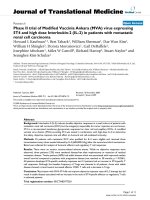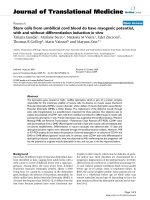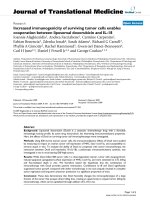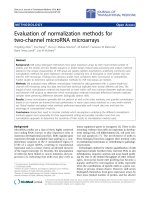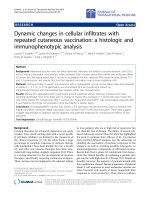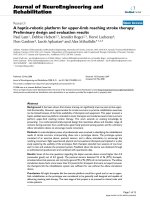báo cáo hóa học:" Negative pressure wound therapy for soft tissue injuries around the foot and ankle" ppt
Bạn đang xem bản rút gọn của tài liệu. Xem và tải ngay bản đầy đủ của tài liệu tại đây (1.14 MB, 5 trang )
BioMed Central
Page 1 of 5
(page number not for citation purposes)
Journal of Orthopaedic Surgery and
Research
Open Access
Research article
Negative pressure wound therapy for soft tissue injuries around the
foot and ankle
Hyun-Joo Lee
1
, Joon-Woo Kim
1
, Chang-Wug Oh*
1
, Woo-Kie Min
1
, Oog-
Jin Shon
2
, Jong-Keon Oh
3
, Byung-Chul Park
1
and Joo-Chul Ihn
1
Address:
1
Department of Orthopedic Surgery, Kyungpook National University Hospital, Daegu, Korea,
2
Department of Orthopedic Surgery,
Yeungnam University Hospital, Daegu, Korea and
3
Department of Orthopedic Surgery, Korea University Guro Hospital, Seoul, Korea
Email: Hyun-Joo Lee - ; Joon-Woo Kim - ; Chang-Wug Oh* - ; Woo-
Kie Min - ; Oog-Jin Shon - ; Jong-Keon Oh - ; Byung-Chul Park - ; Joo-
Chul Ihn -
* Corresponding author
Abstract
Background: This study was performed to evaluate the results of negative pressure wound
therapy (NPWT) in patients with open wounds in the foot and ankle region.
Materials and methods: Using a NPWT device, 16 patients were prospectively treated for soft
tissue injuries around the foot and ankle. Mean patient age was 32.8 years (range, 3–67 years). All
patients had suffered an acute trauma, due to a traffic accident, a fall, or a crush injury, and all had
wounds with underlying tendon or bone exposure. Necrotic tissues were debrided before applying
NPWT. Dressings were changed every 3 or 4 days and treatment was continued for 18.4 days on
average (range, 11–29 days).
Results: Exposed tendons and bone were successfully covered with healthy granulation tissue in
all cases except one. The sizes of soft tissue defects reduced from 56.4 cm
2
to 42.9 cm
2
after NPWT
(mean decrease of 24%). In 15 of the 16 cases, coverage with granulation tissue was achieved and
followed by a skin graft. A free flap was needed to cover exposed bone and tendon in one case. No
major complication occurred that was directly attributable to treatment. In terms of minor
complications, two patients suffered scar contracture of grafted skin.
Conclusion: NPWT was found to facilitate the rapid formation of healthy granulation tissue on
open wounds in the foot and ankle region, and thus, to shorten healing time and minimize
secondary soft tissue defect coverage procedures.
Introduction
Tendon and/or bone exposure commonly occurs in the
foot and ankle region after acute trauma [1]. The conven-
tional treatment method used for these uncovered, open
wounds in the foot and ankle is skin grafting after the for-
mation of healthy granulation tissue by wet dressing [2].
However, the duration of treatment may be prolonged,
and patients may experience severe pain during dressing
changes [3]. Furthermore, it is difficult to form healthy
granulation tissue by simple wet dressing, when a tendon,
Published: 9 May 2009
Journal of Orthopaedic Surgery and Research 2009, 4:14 doi:10.1186/1749-799X-4-14
Received: 25 August 2008
Accepted: 9 May 2009
This article is available from: />© 2009 Lee et al; licensee BioMed Central Ltd.
This is an Open Access article distributed under the terms of the Creative Commons Attribution License ( />),
which permits unrestricted use, distribution, and reproduction in any medium, provided the original work is properly cited.
Journal of Orthopaedic Surgery and Research 2009, 4:14 />Page 2 of 5
(page number not for citation purposes)
bone, or implant is exposed. Accordingly, free flap surgery
is often required, which requires substantial effort and
introduces the issue of donor site morbidity [4].
Negative pressure wound therapy (NPWT) was first
described by Argenta and Morykwas [2]. This technique
can be used to cover exposed bone or soft tissue defects
without frequent dressing changes, and reduces chronic
edema and increases local blood supply, which enhances
the formation of healthy granulation tissue. Several
reports have been issued on the application of NPWT to
soft tissue defects of the extremities, abdomen and chest
[5,6]. However, reports regarding its use in the foot and
ankle region are limited, though in this region tendon and
bone exposures frequently occur after external injury or
due to chronic ulcerative disease. The purpose of this
study was to determine how NPWT helps healing and
whether the technique can reduce the need for flap sur-
gery for the treatment of acute or chronic open wounds in
the foot and ankle region.
Materials and methods
Over the four year period from 2003 to 2006, 16 patients
(12 males and 4 females) with soft tissue injuries in the
foot and ankle region were treated with an NPWT device
(V.A.C.,
®
Vacuum Assisted Closure, KCI, San Antonio,
United States) at the authors' institute. All 16 patients
were followed for more than 12 months (mean: 19
months, range: 13–39 months). Mean patient age was
32.8 (range: 3–67). All patients had experienced an acute
injury, caused by either a traffic accident in 12, a falling
from a height in 2, and a crush injury in 2. Wound loca-
tions were on the medial side of the ankle in 3 cases, the
lateral side of the ankle in 1 case, and of the dorsum of the
foot in 12 cases. All patients had at least one tendon or
bone exposed at the initiation of NPWT, and four had an
associated infection (Table 1).
Technique
An NPWT device was applied after debriding necrotized
tissues and cleansing contaminated wounds. When frac-
tures were present, internal or external fixation was per-
formed before application. The V.A.C.
®
system was used
throughout. This consists of an evacuation tube, a collect-
ing canister, a vacuum pump, and a multiporous poly-
urethane sponge, which directly contacts the wound. The
sponge, which was designed to be 3–5 cm larger than
wounds, was applied to defect sites and sealed with trans-
parent cohesive film. The vacuum dressing was changed
every 3–4 days and most procedures were performed at
bedside. However, when necessary, debridement was per-
formed in an operating room. A negative pressure vacuum
pump was applied to wounds in continuous mode at a
pressure of 100~125 mmHg. NPWT was stopped after
confirming the formation of healthy granulation tissue.
Skin grafting was performed when further coverage was
required.
Wound types (acute or traumatic versus chronic) and
location were noted, and durations, numbers, and fre-
Table 1: Patient and wound details before and after negative pressure wound therapy
No Age Sex Injury Site Wound
grade
(before)
Wound
grade
(after)
Size
(before)
Size
(after)
Duration Additional
procedure
Complication
1 3 M Ped TA Dorsal 2 1 92 60 14 STSG
2 7 M Ped TA Dorsal 3 1 23 9 17 STSG scar contracture
3 7 M Ped TA Dorsal 2 1 60 42 16 STSG scar contracture
4 10 M Ped TA Dorsal 3 1 36 16 13 STSG
5 11 M Sports
injury
Lateral 4 1 27 20 23 STSG
6 18 F In car TA Dorsal 2 1 70 50 19 STSG
7 22 M In car TA Dorsal 3 1 94.5 87 17 STSG
826MF/DMedial2 1 9 4 12 STSG
9 27 M In car TA Dorsal 3 1 103 85 15 STSG
10 44 M Crushing Dorsal 3 1 52 35 17 STSG
11 47 F Ped TA Dorsal 2 1 151 91 27 STSG
12 53 M F/D Medial 2 1 14 8 11 STSG
13 54 F Crushing Medial 3 1 72.5 17 12 STSG
14 63 F Motorcycle
TA
Dorsal 3 1 12 8 18 FTSG
15 66 M In car TA Dorsal 3 3 45 39 21 free flap
16 67 M Ped TA Dorsal 3 1 104 81 29 STSG
Mean 32
(years-
old)
2.69 1.13 56.4(cm
2
) 42.9(cm
2
) 18.4
(days)
TA: traffic accident, Ped(pedestrian), F/D: fall down, STSG(split thickness skin graft), FTSG(full thickness skin graft)
Journal of Orthopaedic Surgery and Research 2009, 4:14 />Page 3 of 5
(page number not for citation purposes)
quencies of V.A.C. system applications were recorded.
Before and after NPWT treatment, sizes of soft tissue
defects were assessed using squared paper. Wounds were
categorized into 5 groups based on degree of exposure and
the presence of concomitant infection, which was graded
from 0 to 4 (Table 2). Final coverage techniques, includ-
ing primary closure, split thickness skin grafting, and
pedicled local and vascularized free flap grafting were doc-
umented. Furthermore, any complications attributable to
NPWT treatment were noted.
Results
The mean duration of therapy was 18.4 days (range, 11–
29 days), and dressings were changed 4.5 times on aver-
age. Mean wound size at treatment initiation was 56.4
cm
2
(9–151 cm
2
), and this reduced to 42.9 cm
2
(4–81
cm
2
) at treatment completion, an average wound area
reduction of 24%. Fifteen of the 16 patients achieved an
improved wound status, and in these exposed tendons or
bone was covered with healthy granulation tissue (Figures
1, 2). After NPWT, skin grafting was performed to cover
granulation tissue in 15 cases (a split-thickness skin graft
in 14 cases and a full-thickness skin graft in 1 case). One
patient experienced treatment failure, and required a free
flap to cover exposed bone and tendon. The average
wound grade was 2.69 at the start of treatment, and 1.13
at the end of treatment.
No complication occurred that could be directly attrib-
uted to NPWT, such as, a deep infection or bleeding. In
terms of minor complications, four patients experienced
itchiness of skin in the region of NPWT application. In
addition, 2 patients experienced scar contractures in
grafted areas, which were rescued using a releasing proce-
dure.
Discussion
Traumatic injuries around the foot and ankle are often
associated with significant skin loss, which results in the
exposure of tendons, bone, or hardware, and associated
wound-management difficulties. These injuries are simi-
lar in many ways, to chronic ulcerative lesions of the foot
associated with ischemic diseases, such as, diabetes melli-
tus. The rapid formation of granulation tissue and blood
vessels are essential for the healing of these wounds. Tra-
ditionally, frequent wet dressing changes (3–4 times/day)
are used to treat such cases, but this treatment is pro-
tracted and painful [3,7]. Furthermore, interstitial fluid
from open wounds reduces local blood supply and dis-
turbs wound healing due to its collagenase and metallo-
proteinase constituents [8,9]. From this viewpoint, NPWT
is highly effective at clearing interstitial fluid, and in the
A severe open fracture around the ankle in a 20 year-old woman (A & B)Figure 1
A severe open fracture around the ankle in a 20 year-
old woman (A & B). After the debridement of necrotized
tissue (C), NPWT was applied (D).
Table 2: Details of the open wound scoring system used
Score (grade) Status of wound
0 Closed wound
1 Skin or soft tissue defect
2 Bone, tendon, implant exposure(any 1)
3 Bone, tendon, implant exposure(any combination of 2 or more)
4 Associated or Residual infection
Journal of Orthopaedic Surgery and Research 2009, 4:14 />Page 4 of 5
(page number not for citation purposes)
majority of our patients, wounds were covered with
healthy granulation tissue after 4.5 sponge changes, with-
out additional flap surgery. DeFranzio
5
also reported that
NPWT enhances rapid granulation formation in over 80%
of patients as compared with a simple wet dressing. Fur-
thermore, it has been well reported that NPWT provides a
continuous physical stimulus that enhances the forma-
tion of new vessels and granulation tissues [10,11].
Soft tissue defects in the foot and ankle region usually
require local or free flap surgery when a skin graft proce-
dure is not applicable due to limited granulation tissue
formation
1
. A split-thickness skin graft is not recom-
mended for wounds with exposed bone or neurovascular
structures, or for wounds involving the weight-bearing
surface of the foot [12]. In a comparative study of tradi-
tional dressings and NPWT for lawnmower injuries of the
lower leg [13], the need for free flap surgery was found to
be decreased by 30%. A remarkable reduction in the
requirement for secondary soft tissue operation is
believed to be a big advantage of NPWT [14]. Dedmond
[15] also reported that wounds of grade 3 with an accom-
panying open tibial fracture healed without the need for a
secondary soft tissue operation, such as, a free flap. In the
present study, the severities of open wounds were notice-
ably reduced after NPWT; only one patient needed a free
flap to cover exposed bone and tendon.
The prevention of deep infection is essential during the
treatment of soft tissue defects, and simple wet dressing
may be inadequate in this context, because wounds are
inevitably exposed to the atmosphere. On the other hand,
NPWT not only seals open wounds but evacuates hemato-
mas, exudates, and possible pathogens by the application
of negative pressure [10,16,17]. Furthermore, it has been
reported that NPWT is effective at treating deep infections
[18]. In the present study, no case of infection during the
treatment period occurred. Accordingly, we consider that
NPWT probably also reduces soft tissue defect infection
rates.
Some technical difficulties have been reported when
NPWT was used to treat foot wounds [19], but we did not
encounter these problems. In terms of complications, we
did encounter 2 cases of skin graft scar contractures, which
can reduce foot function. Successful scar release was
achieved in these two cases. But, in certain cases, flap sur-
gery may be considered to prevent scar contractures [20],
instead of NPWT.
This study has several limitations that require considera-
tion, namely, that the size of data is small, and there was
no control group, which reduced objectivity. We suggest
that a prospective randomized multicenter trial be under-
taken to determine the merits of NPWT for the treatment
of soft tissue defects of the ankle and foot. However, based
on the results of previous studies on its use for the treat-
ment of other injuries at other locations, it appears that
NPWT plays a significant role in the formation of granula-
tion tissue and in the prevention of infection [21].
Our results add to growing evidence that NPWT is a useful
adjunctive treatment for open wounds around the foot
and ankle. In the present study, it was found to facilitate
the rapid formation of granulation tissue, to shorten heal-
ing time, and to reduce remarkably the need for addi-
tional soft tissue reconstructive surgery.
Competing interests
The authors declare that they have no competing interests.
Authors' contributions
CWO, HJL carried out concept design, patient recruitment
and follow-up, data collection and analysis, and manu-
script writing. JWK carried out literature search and data
analysis. WKM carried out data collection, patient follow
up, data analysis and manuscript writing. OJS, JKO, BCP,
JCI conceived of the study, and participated in its design
and coordination. All authors read and approved the final
manuscript for publication.
Acknowledgements
The authors thank Hwa-Ryun, Sarah, Park (Archmere Academy, Senior
Wilmington, Delaware, United States) for her editorial assistance with the
manuscript. This work was supported by BK 21. This study was conducted
at Kyungpook National University Hospital, Daegu, Korea
References
1. Mendonca DA, Cosker T, Makwana NK: Vacuum-assisted closure
to aid wound healing in foot and ankle surgery. Foot Ankle Int
2005, 26:761-766.
2. Argenta LC, Morykwas MJ: Vacuum-assisted closure: a new
method for wound control and treatment: clinical experi-
ence. Ann Plast Surg 1997, 38:563-576.
At 22 days of NPWT, sufficient granulation covered tendons (E) to perform skin graftFigure 2
At 22 days of NPWT, sufficient granulation covered
tendons (E) to perform skin graft. At 1 year postopera-
tively, the wound had healed well (F & G).
Publish with BioMed Central and every
scientist can read your work free of charge
"BioMed Central will be the most significant development for
disseminating the results of biomedical research in our lifetime."
Sir Paul Nurse, Cancer Research UK
Your research papers will be:
available free of charge to the entire biomedical community
peer reviewed and published immediately upon acceptance
cited in PubMed and archived on PubMed Central
yours — you keep the copyright
Submit your manuscript here:
/>BioMedcentral
Journal of Orthopaedic Surgery and Research 2009, 4:14 />Page 5 of 5
(page number not for citation purposes)
3. McCallon SK, Knight CA, Valiulus JP, Cunningham MW, McCulloch
JM, Farinas LP: Vacuum-assisted closure versus saline-mois-
tened gauze in the healing of postoperative diabetic foot
wounds. Ostomy Wound Manage 2000, 46:28-32.
4. DeFranzo AJ, Argenta LC, Marks MW, Molnar JA, David LR, Webb
LX, Ward WG, Teasdall RG: The use of vacuum-assisted closure
therapy for the treatment of lower-extremity wounds with
exposed bone. Plast Reconstr Surg 2001, 108:1184-1191.
5. DeFranzo AJ, Marks MW, Argenta LC, Genecov DG: Vacuum
assisted closure for the treatment of degloving injuries. Plast
Reconstr Surg 1999, 104:2145-2148.
6. Webb LX: New techniques in wound management: vacuum
assisted wound closure. J Am Acad Orthop Surg 2002, 10:303-311.
7. Lionelli GT, Lawrence WT: Wound dressings. Surg Clin North Am
2003, 83:617-638.
8. Bucalo B, Eaglstein WH, Falanga V: Inhibition of cell proliferation
by chronic wound fluid. Wound Repair Regen 1993, 1:181-186.
9. Wysocki AB, Staiano-Coico L, Grinnell F: Wound fluid from
chronic leg ulcers contains elevated levels of metalloprotei-
nases MMP-2 and MMP-9. J Invest Dermatol 1993, 101:64-68.
10. Morykwas MJ, Argenta LC, Shelton-Brown EI, McGuirt W: Vacuum-
assisted closure: a new method for wound control and treat-
ment: animal studies and basic foundation. Ann Plast Surg 1997,
38:553-562.
11. Yuan-Innes MJ, Temple CL, Lacey MS: Vacuum-assisted wound
closure: A new approach to spinal wounds with exposed
hardware. Spine 2001, 26:E30-33.
12. Alonso JE, Sanchez FL: Lawn-mower injuries in children: a pre-
ventable impairment. J Pediatr Orthop 1995, 15:83-89.
13. Shilt JS, Yoder JS, Manuck TA, Jacks L, Rushing J, Smith BP: Role of
vacuum-assisted closure in the treatment of pediatric lawn-
mower injuries. J Pediatr Orthop 2004, 24:
482-487.
14. Mooney JF 3rd, Argenta LC, Marks MW, Morykwas MJ, DeFranzo AJ:
Treatment of soft tissue defects in pediatric patients using
the V.A.C. system. Clin Orthop 2000, 376:26-31.
15. Dedmond BT, Kortesis B, Punger K, Simpson J, Argenta J, Kulp B,
Morykwas M, Webb LX: Subatmospheric pressure dressings in
the temporary treatment of soft tissue injuries associated
with type III open tibial shaft fractures in children. J Pediatr
Orthop 2006, 26:728-732.
16. Stannard JP, Robinson JT, Anderson ER, McGwin G Jr, Volgas DA,
Alonso JE: Negative pressure wound therapy to treat hemato-
mas and surgical incisions following high-energy trauma. J
Trauma 2006, 60:1301-1306.
17. Wongwarawat MD, Schnall SB, Holtom PD, Moon C, Schiller F: Neg-
ative pressure dressings as an alternative technique for the
treatment of infected wounds. Clin Orthop 2003, 414:45-48.
18. Canavese F, Gupta S, Krajbich JI, Emara KM: Vacuum-assisted clo-
sure for deep infection after spinal instrumentation for scol-
iosis. J Bone Joint Surg Br 2008, 90:377-381.
19. Clare MP, Fitzgibbons TC, McMullen ST, Stice RC, Hayes DF, Henkel
L: Experience with the vacuum assisted closure negative
pressure technique in the treatment of non-healing diabetic
and dysvascular wounds. Foot Ankle Int 2002, 23:896-901.
20. Attinger CE, Ducic I, Cooper P, Zelen CM: The role of intrinsic
muscle flaps of the foot for bone coverage in foot and ankle
defects in diabetic and nondiabetic patients. Plast Reconstr Surg
2002, 110:1047-1054.
21. Herscovici D Jr, Sanders RW, Scaduto JM, Infante A, DiPasquale T:
Vacuum-assisted wound closure (VAC therapy) for the man-
agement of patients with high-energy soft tissue injuries. J
Orthop Trauma 2003, 17:683-88.

